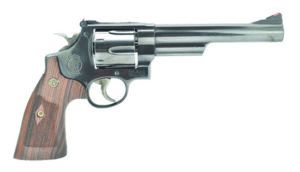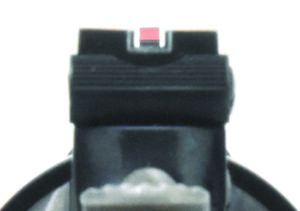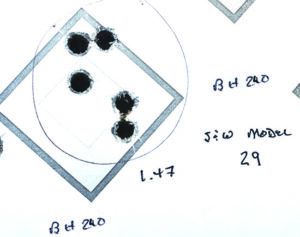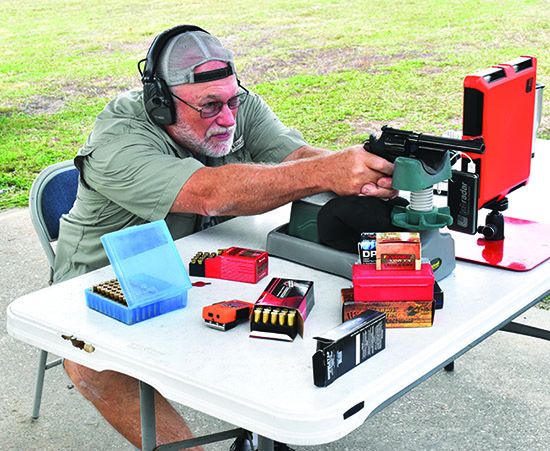Considering our readers’ interest in the 10mm cartridge in recent years, we weren’t too surprised to receive a request to cover the 41 Remington Magnum. With a tad more energy than the 10mm, the 41 Magnum essentially occupies the same space in the energy rankings as its 40-bore brother, but it does so in a rimmed case more suitable for a revolver. But while the 10mm has recovered from its “can’t get no respect” status, the 41 Magnum still suffers from mediocre sales, and we’re not sure why.
Perhaps one of the reasons for the lackadaisical sales is the dearth of firearms chambered in a true .410-diameter bullet. As of this writing, Smith & Wesson is the only company that still catalogs revolvers chambered in 41 Magnum. But that’s OK — they invented the chambering, and they know more than a little about it. In fact, Smith & Wesson invented all three of the earliest magnum chamberings and a new class of revolvers to go with them.
We decided to visit with the latest version of these classic cartridges. Wanting to stay true to the early magnum-capable platforms, we secured three S&W “N” Frame revolvers chambered in 357 Magnum (Model 27), 44 Magnum (Model 29), and 41 Magnum (Model 57). All three of our test guns have 6-inch (or longer) barrels. All three have good, adjustable sights. All three are heavy enough to dampen recoil from the magnum cartridges. All three have top straps that have been tapped and drilled for a scope mount. But could they shoot well enough to earn the moniker of a hunting handgun? We had to find out.
Our first test piece was the 357 Magnum Model 27-9 with the 6.5-inch barrel, Model No. 150341, $1189. Our 44 Magnum Model 29-10 sample was also a 6.5-inch barrel model, and it included a wood presentation case in Model No. 150145, $1309. Then, of course, we looked at the revolver that started this quest, a Model 57-6 chambered in 41 Magnum Model No. 150481, $979. Here’s how they performed at the range.
Smith & Wesson Model 29-10 No. 150145 44 Remington Magnum
$1309
GUN TESTS GRADE: B
Not quite as accurate as the other two in our tests, this Model 29 would still do anything we needed from a hunting or target handgun. It needed a smooth trigger to help with handling the power.

| Action Type | Revolver |
| Overall Length | 12.1 in. |
| Overall Height | 6.25 in. |
| Maximum Width | 1.715 in. |
| Weight Unloaded | 3.0 lbs. |
| Weight Loaded | 3.3 lbs. |
| Receiver Material | Blued carbon steel |
| Front Strap Height | 2.6 in. |
| Back Strap Height | 4.9 in. |
| Barrel Length | 6.5 in. |
| Grip Thickness Maximum | 1.432 in. |
| Grip Circumference | 5.25 in. |
| Rear Sight | Adjustable white outline |
| Front Sight | Red insert ramp |
| Sight Radius | 8.5 in. |
| Trigger Pull Weight Single Action | 5.0 lbs. |
| Trigger Pull Weight Double Action | 11.5 lbs. |
| Trigger Span | 3.25 in. |
| Safety | Manual lock |
| Warranty | Lifetime service policy |
| Telephone | (800) 331-0852 |
| Website | Smith-Wesson.com |
| Made In | USA |
Clint Eastwood drove this pistol onto the world stage with the release of Dirty Harry in 1971. Described in the movie as the “most powerful handgun in the world, and will blow your head clean off,” the 44 Magnum now falls short of that claim by several orders of magnitude. That said, the 44 Magnum is still a formidable fighting and hunting round. The versatility of the cartridge is incredible, with appropriate bullets ranging from 180 grains to more than 300 grains. Velocities run from downright sedate to T-Rex worthy.
S&W probably wishes that movie had come out earlier. Introduced in 1955, the revolver was renamed from the 44 Magnum to the Model 29 in 1957. Sales were only fair until the debut of Dirty Harry. For years afterward, the handguns just almost weren’t available, and there was a premium paid for what was available to buy. Many found the 44 Magnum was just more oomph than they wanted. We’ve heard many stories of slightly used 44 Mags for sale along with a 50-round cartridge box containing 44 rounds. The owners had fired only one cylinder’s worth. We like the 44 Magnum — in limited doses. We really enjoy shooting 44 Specials in them with 245-grain hard-cast-lead bullets doing about 900 fps. Those are a pleasure to shoot, will knock down just about anything hit with one, and are easy on the hands as well as the budget.

We love to compare old versus new when possible. The history is interesting as is the progress. As with the Model 27 and the K Frames, our Houston team has an old Model 29 in our collection. This 29-2 dates back to the early 1970s and some very different production methods. So how does S&W’s latest and greatest stack up against a classic?
In many respects, the two pistols are very similar. The current Model 29 is 4 ounces heavier, but it has another 2.5 inches of barrel. The cylinder on the 29-10 is actually 0.050 inch shorter than the 29-2, but even 320-grain long-nosed bullets fit in the 29-10 just fine. Both have color case-hardened hammers and triggers, though the earlier versions’ trigger is smooth, which we prefer. Sights are identical with a red-ramped pinned front sight and a white-outlined rear. Both sport grooved top straps for glare reduction. The barrel on the 29-10 is about 0.020 inch narrower than the 29-2 at the muzzle and more than that near the end of the frame. Timing was excellent on both, with the cylinder locking up on all chambers at the correct point in the rotation. Both cylinders rotated smoothly on the bushings — with the newer model showing easier movement.

The different eras also produced some different results. The 29-2 has a hammer-mounted firing pin and the 29-10’s is frame mounted. And the 29-10 has an onboard lock. Those extra moving parts in the middle of a complex mechanism concern us. We, however, have never experienced a problem with the lock and have seen very little, even anecdotal, evidence that problems have occurred. We just leave them turned off and forget about them. Also, there is no more pinned barrel or recessed cylinder, not that either were necessary. Looking at the finish work of the 29-10, we find nothing to complain about. The bluing may not be quite as bright and deep, but all surfaces still show first-rate polishing. Without the 50-year-old Model 29 to compare the current sample against, we wouldn’t have bothered to mention the finish. The front of the cylinder is still beveled for reholstering — maybe not as much as the 29-2, but still well done. As with the other N Frames tested, the top strap is already drilled and tapped for a scope mount. Leupold, Burris, and more make outstanding pistol scopes with a variety of magnification. Check out JackWeigand.com for a great Picatinny top rail for your wheelgun’s scope or other optic.
The Model 29 was not quite as accurate as the other two N Frames tested, and we readily admit that the problem may have been the testers. The Hornady 200-grain Flex load pushed bullets faster than 1400 fps, achieving almost 900 foot-pounds of energy — a stout load to say the least. The Black Hills 240-grain JHP (which seems to be the de facto load for the 44 Magnum) did 1247 fps and 829 foot-pounds of energy and registered an average 1.71-inch five-shot group with the Black Hills load. Not too shabby. The Doubletap ammunition was an out-of-body experience. We have handloaded gas-checked 320-grain hard-cast lead bullets before to somewhere between the 1100 and 1220 fps range. The Doubletap loads averaged 1343 fps out of the Model 29. Our shooters’ initial reactions were not muttered expletives, rather full-throated versions. We expect recoil from that kind of energy, but this got our attention.
Our Team Said: We mentioned the serrated trigger earlier. A smooth (non-grooved) trigger would be much more comfortable to shoot with this hard-recoiling handgun.
| 357 Magnum, 41 Magnum, and 44 Magnum Range Data | |||
| Smith & Wesson Cor-Bon DPX Model 27 357 Magnum | Cor-Bon DPX 125-grain JHP | Winchester 158-grain JSP | Doubletap 200-grain Hardcast |
| Average Velocity | 1236 fps | 1154 fps | 1284 fps |
| Muzzle Energy | 424 ft.-lbs. | 467 ft.-lbs. | 733 ft.-lbs. |
| Average Group Size | 1.75 in. | 1.67 in. | 1.93 in. |
| Best Group Size | 1.47 in. | 1.39 in. | 1.71 in. |
| Smith & Wesson Model 57 41 Magnum | Barnes 180-grain Vortex | HSM 210-grain SWC | Remington 210-grain JSP |
| Average Velocity | 1381 fps | 904 fps | 1294 fps |
| Muzzle Energy | 762 ft.-lbs. | 381 lbs. | 781 ft.-lbs. |
| Average Group Size | 2.31 in. | 1.69 in. | 1.83 in. |
| Best Group Size | 1.65 in. | 1.51 in. | 1.63 in. |
| Smith & Wesson Model 29 44 Magnum | Hornady 200-grain Flex | Black Hills 240-grain JHP | Doubletap 320-grain Hardcast |
| Average Velocity | 1407 fps | 1247 fps | 1343 fps |
| Muzzle Energy | 879 ft.-lbs. | 829 ft.-lbs. | 1282 ft.-lbs. |
| Average Group Size | 2.77 in. | 1.71 in. | 3.45 in. |
| Best Group Size | 1.83 in. | 1.47 in. | 2.35 in. |
All shooting was done at American Shooting Centers (AmericanShootingCenters.com) in Houston. Accuracy was tested at 15 yards by shooting multiple five-shot groups from a well-sandbagged Caldwell Pistolero shooting rest (MidwayUSA.com 517357, $2) assisted by a Mini DRC Fortune Cookie from Wiebad.com ($75, MINIFC). We chose a variety of ammo types and weights for each cartridge by using the Ammoseek.com search feature. In 357 Magnum, we found Cor-bon DPX 125-grain solid-copper bullets, Winchester SuperX 158-grain JSPs, and Doubletap 200-grain hard cast rounds. The 41 Remington Magnum selection included Barnes VOR-TX 180-grain XPB cartridges, HSM 210-grain Cowboy Loads, and Remington’s 210-grain XTP hollow point. The 44 Remington Magnum fodder also covered the weight and power spectrum with Hornady 200-grain MFX, Black Hills 240-grain JHP, and Doubletap 320-grain hard-cast bullets.
| DRILL DATA | |||
| Pistol | 1st Shot | Split Average | Total Time |
| Model 27 | 0.933 | 0.382 | 1.697 |
| Model 29 | 1.217 | 0.772 | 2.760 |
| Model 57 | 1.08 | 0.468 | 2.017 |
Process: Fire three shots from low ready at a USPSA target at 8 yards. Numbers are averages for three repetitions. Times are in seconds.
Written and photographed by Joe Woolley, using evaluations from Gun Tests Team members. GT




























